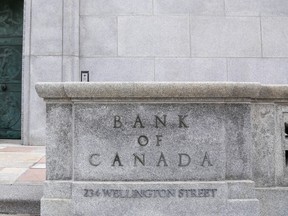Financial Post columnist Kevin Carmichael, editor of the FP Economy newsletter, unpacks the week in economics
Article content
Financial Post columnist Kevin Carmichael, editor of the FP Economy newsletter, unpacks the week in economics.
Advertisement
This advertisement has not loaded yet, but your article continues below.
Article content
Macklem’s dashboard
Bank of Canada Governor Tiff Macklem has declared that he intends to oversee a “complete” recovery from the COVID-19 recession. He hasn’t said explicitly what that means, but we can guess, based on references he’s made to various indicators. It’s safe to say that Macklem won’t take his foot off the gas until the jobless rate is back below six per cent, for example. And he’s implied that employment must climb to around 19.3 million, the pre-pandemic level plus the jobs that probably would have been created if not for the epic economic collapse that followed the first wave of lockdowns. Macklem has also been clear that he doesn’t intend to leave anyone behind, so he will also want to see that women, youth, and other groups that were hit disproportionately hard by the crisis are back to where they were at the start of 2020.
Advertisement
This advertisement has not loaded yet, but your article continues below.
Article content
So, a complete recovery by the governor’s definition is a long way off, but we’re getting there. Statistics Canada reported on July 9 that employers added some 240,000 positions in June, nearly reversing the third-wave losses of April and May, when most provinces tightened health measures to crush the latest spread of the coronavirus. That pushed total employment to 18.8 million, compared with 19.1 million in February 2020 and about three per cent below Macklem’s unofficial target. The unemployment rate dropped to 7.8 per cent from 8.2 per cent in May, led by a surge in part-time hiring as restaurants and retail shops were permitted to reopen.
Statistics Canada completed its latest Labour Force Survey on June 19, so it’s possible the agency underestimated the full extent of hiring last month. One of Macklem’s favourite gauges, below, shifted dramatically in a positive direction. The number of employees who work for a paycheque crossed its pre-pandemic level in June, suggesting much of whatever weakness remains is concentrated in self-employment. More importantly, employment in one of two lower-wage groups finally climbed back to where it was in February. That’s progress.
Advertisement
This advertisement has not loaded yet, but your article continues below.
Article content

Freeland’s guardrails
The growing excitement about the economy’s prospects this summer is akin to the sense of euphoria that distance runners feel when the end is in sight. But there is still more race to run. The economy remains in a hole and the latest hiring numbers weren’t all positive. Factory and construction jobs dropped in June, which could indicate that post-pandemic supply-chain bottlenecks and off-the-charts commodity prices are becoming a headwind for demand.
Total hours worked, an indicator that Finance Minister Chrystia Freeland is watching to help calibrate emergency benefits, dropped during the third wave and were little changed in June. COVID-19 is the most important economic variable right now, but it’s not the only one.
Advertisement
This advertisement has not loaded yet, but your article continues below.
Article content


Canada’s job market bounces back strongly, reversing bulk of lockdown losses

Quebec backs vaccine passport to banish lockdowns and keep economy open

COVID-19 pushed 22 million out of the job market in major economies

Labour shortages, competitiveness and inflation: The key risks to Canada’s economy
Taper time
The jobs data pretty much guarantee the Bank of Canada will reduce its purchases of Government of Canada bonds this week, but Governor Tiff Macklem probably would have been inclined to do so even if the hiring number hadn’t exceeded expectations.
Macklem and his four deputies began their interest-rate deliberations last week with some good news. The central bank’s latest Business Outlook Survey (BOS) suggests executives are preparing for a burst of demand as soon as health restrictions ease. The quarterly poll also flagged some emerging inflation risks, which argues in favour of taking advantage of windows to reduce monetary stimulus, just in case worries about price increases become entrenched.
Advertisement
This advertisement has not loaded yet, but your article continues below.
Article content
Overall business sentiment, which the Bank of Canada calculates by amalgamating answers to core questions into a single index, rose to its highest on record. “No firms reported signs of a deterioration in demand,” the report said.
To be sure, some 40 per cent of respondents said current sales were weaker than a year earlier, and companies “hardest hit” by the pandemic doubt that sales will recover to previous levels over the next 12 months. So to a certain extent, current optimism is a product of how terrible things were a year ago. With vaccinates rates climbing quickly, it can only get better.
The traumatic collapse of the economy in the spring of 2020 is causing a mismatch in supply and demand now. Companies prepared for the worst, firing workers and freezing investment. But unprecedented emergency benefits cushioned the decline, leaving households with money to spend. So demand is coming back stronger than companies’ ability to supply it. Expectations of upward pressure on wages are near the highest on record, and predictions of higher prices remained at elevated levels for the third consecutive quarter.
Advertisement
This advertisement has not loaded yet, but your article continues below.
Article content
Thirty-five per cent of respondents said they expected inflation would exceed three per cent over the next 12 months, compared with 13 per cent in the previous survey. Executives haven’t been this skeptical of the Bank of Canada’s ability to keep prices from breeching the high end of its comfort zone since the early days of the Great Recession in 2008.
Still, about half of respondents said they thought inflation would hold between two per cent and three per cent, an increase from the previous quarter, suggesting the Bank of Canada has successfully avoided deflation, which was its primary concern a year ago. A similar number of firms reported that they expected their prime rates of interest would increase over the next two years.
Advertisement
This advertisement has not loaded yet, but your article continues below.
Article content
That’s a reasonable expectation. The Bank of Canada’s current guidance is that it will leave the benchmark rate pinned near zero at least until the second half of next year, which is when Macklem has said he will start thinking about adjusting his main policy lever.
But borrowing rates likely will drift higher over the interim as the central bank edges out of the bond market. In April, the central bank dropped its weekly purchases of federal debt to $3 billion, and it likely will decide to shave its bond-buying program to at least $2 billion this week. The data are too strong to justify so much stimulus.
The Bank of Canada is in a tricky spot, though. Macklem and his deputies are confident the burst of inflation this spring is temporary, but they can’t assume they are correct. At the same time, if they hedge against price increases too aggressively by reducing stimulus, they risk smothering a recovery that is still well short of Macklem’s goals.
Advertisement
This advertisement has not loaded yet, but your article continues below.
Article content
In all likelihood, the central bank will err on the side of growth. Before she resigned at the end of last year, Carolyn Wilkins, the former senior deputy governor, said the Bank of Canada could consider “probing” the limits of its inflation mandate, an acknowledgement that the central bank’s fixation with its two-per-cent target might have come at the expense of achieving full employment.
Employment is Macklem’s his primary goal for now. Don’t be surprised if he’s willing to stomach a little more inflation in order to achieve it.
• Email: kcarmichael@postmedia.com | Twitter: carmichaelkevin
_____________________________________________________________
If you liked this story, sign up for more in the FP Economy newsletter.
_____________________________________________________________
Advertisement
This advertisement has not loaded yet, but your article continues below.
Postmortem: Time for the BoC to taper
2021-07-12 09:00:10





